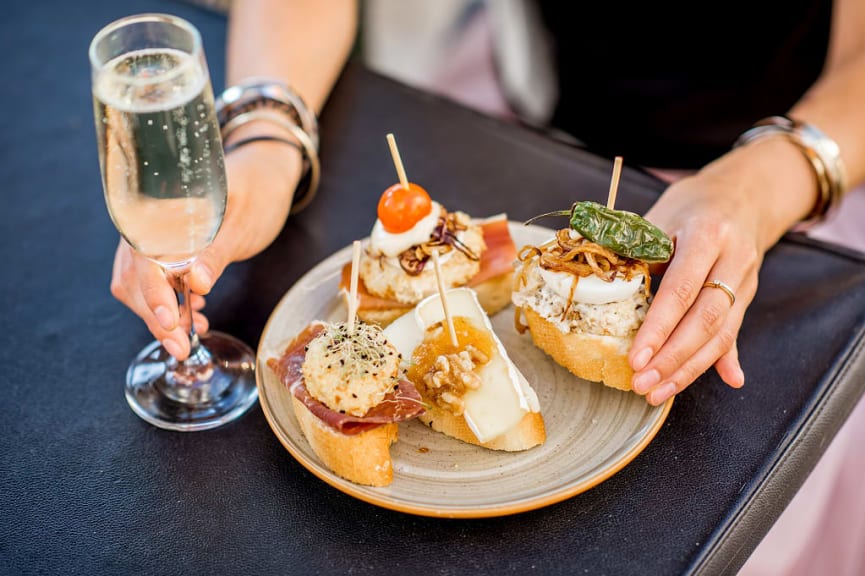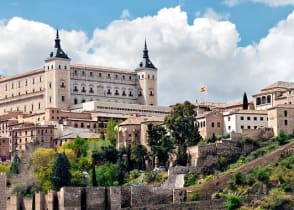An Expert Guide to Spanish Tapas

The flavors and forms Spanish tapas take vary substantially based on region
Tapas are a delicious culinary tradition and a famous custom celebrated around the world that you can experience during a Spain trip with this expert guide to Spanish tapas.
The word itself conjures images of Spaniards relaxing on a patio with small plates covering the table, accompanied by a glass of white wine on a warm day. In reality, tapas vary in size, preparation, and eating habits based on region. Snacking or dining on tapas is a uniquely different experience in Seville than in Pamplona, in Madrid versus Barcelona.
Some regions have a different name for tapas, in the Basque region, the small dishes are known as pintxos, and this is just one regional difference that you will come to learn about the more you explore Spain.

It is common for patrons to visit several restaurants to sample several variations of tapas
The dish originally acted as a small snack or appetizer people could eat before their meal as it is customary to eat dinner later in the evening. Out of the custom has grown a new style of dining experience referred to as tapear, which loosely translates to dining on tapas. Traveling between bars or restaurants and sampling the flavorful creations of different eateries is known as ir de tapas. Certain cities in Spain continue the aged practice of providing free tapas when customers order a drink. The idea derived from the belief the salt from the food would keep patrons buying more alcohol to quench their thirst. This practice has become rare over time, especially after the growth of tourism and low-budget backpackers but remains popular in cities like Granada.
When wandering around Spain, the diverse explanation of the tapa tradition accounts for numerous regions vying to be the birthplace of the acclaimed Spanish culinary custom. One legend dates the origins to King Alfonso X who ate small portions of food with large quantities of wine after recovering from an illness. The food helped curb the effects of alcohol. He then decreed bars should not serve wine unless accompanied by food, in the belief it would limit public intoxication. One of the more popular accounts of tapas’ origins refers to the derivation of the word tapa, which stems from the verb taper, meaning, “to cover.” Bartenders used a piece of bread topped with cheese and ham on a saucer as a lid to cover patrons’ drinks.

When traveling Spain, certain dishes will commonly appear on tapas menus
- Patatas Bravas – The simple dish from Catalonia consists of diced and fried potatoes topped with a savory, spicy sauce.
- Pan con Tomate – The easy but delicious delicacy stemming from Madrid contains a slice of bread capped with a thin tomato spread.
- Esgarrat – The typical cold dish from Valencia consists of strips of peppers and salted cod.
- Tortilla Española – The traditional dish from Madrid consists of an omelet stuffed with potatoes.
- Croquetas – The shapely fried food consists of a variety of fillings, from meat to fish, potatoes to cheese. The most popular fillings include cod and ham.
- Pimientos de Padrón – The spiced and salted dish stemming from Galicia in northern Spain consists of peppers fried in hot oil and sprinkled with rock salt. Occasionally one of the peppers erupts with extreme heat.

Several delicious tapas blanket a picnic table
The various cities along the vast coastline and rugged hills also boast delicately fried calamari and delicious meatballs in a tomato sauce. Specific dishes have their own names outside of the umbrella of the tapa, such as montadito, an open-faced sandwich or banderilla, a pickled olive, onion, pepper, and pickle on a single skewer. In San Sebastian, the dish is known as a “gilda,” and includes anchovies. The famous region of Andalusia has an extensive list of olives, olive oils, and sizzling fried seafood while expansive central Spain is best-known for cheeses like Manchego, roasted lamb, and suckling pigs.
Whether you indulge in the Moorish-style of cuisine at Murcia or a sauce made of red peppers, tomatoes, onions, and garlic topping cooked ham popular in the Navarra region, the variations of sweet, savory, and spicy flavors will delight and surprise you across Spain.
Want to visit Spain to taste their delicious tapas? View Zicasso's Spain tours here.
Life-Enriching Travel Designed Just for You
- 1
Trips curated by the world’s top destination experts
- 2
Concierge-level service leading up to and during your trip
- 3
Unique, exclusive experiences and insider access





